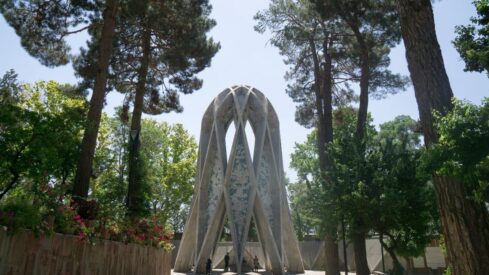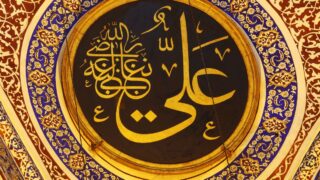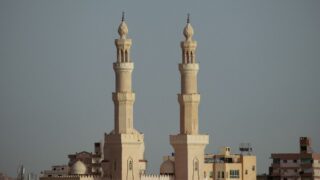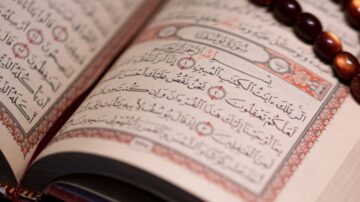Few people have not heard of the Rubaiyat of Omar Khayyam, but the fame of his poetry in the West has only existed since 1839, when Edward Fitzgerald published an English translation of Khayyam’s Rubaiyat (“Quatrains”). It has since become a classic of world literature, and is largely responsible for influencing European ideas about Persian poetry and literature. Prior to that it was his brilliance as a scientist that made his reputation, and his legacy was a calendar more accurate than the one we currently use.
Ghiyath al-Din Abul Fatah Omar Ibn Ibrahim Al-Khayyam was born in Nishappin (now in Iran) in 1044. A literal translation of the name Al-Khayyam means ‘tent maker’ and this may have been the trade of Ibrahim his father. Khayyam played on the meaning of his own name when he wrote:
Khayyam, who stitched the tents of science,
Has fallen in grief’s furnace and been suddenly burned,
The shears of Fate have cut the tent ropes of his life,
And the broker of Hope has sold him for nothing!
Avid Learner in Tumultuous Times
The political events of the 11th century played a major role in the course of Khayyam’s life. The Seljuk Turks were tribes that invaded southwestern Asia in the 11th century and eventually founded an empire that included Mesopotamia, Syria, Palestine, and most of Iran. The Seljuk occupied the grazing grounds of Khorasan and then, between 1038 and 1040, they conquered all of northeastern Iran. The Seljuk ruler, Toghrïl Beg, proclaimed himself sultan at Nishapur in 1038 and entered Baghdad in 1055. It was in this difficult unstable military empire, which also had religious problems as it attempted to establish an orthodox Muslim state, in which Khayyam grew up.
The young Omar was an avid student and quickly became skilled in mathematics, astronomy, and philosophy. He spent most of his life in Persian intellectual centers such as Samarkand and Bukhara, and enjoyed the favor of the Seljuk sultans who ruled the region.
Khayyam wrote several works including Problems of Arithmetic, a book on music and one on algebra before he was 25 years old. In 1070 he moved to Samarkand in Uzbekistan, which is one of the oldest cities of Central Asia. There, Khayyam was supported by Abu Tahir, a prominent jurist of Samarkand, and this allowed him to write his most famous algebra work, Treatise on Demonstration of Problems of Algebra.
Khayyam’s “Astronomical” Achievements
Toghril Beg, the founder of the Seljuk dynasty, had made Esfahan the capital of his domains and his grandson, Malik-Shah Jalal al-Din, had ruled there since 1073. An invitation was sent to Khayyam from Malik-Shah and from his vizier, Nizam al-Mulk, asking Khayyam to go to Esfahan to set up an observatory there. Other leading astronomers were also brought to the observatory in Esfahan, and for 18 years Khayyam led the scientists and produced work of outstanding quality. It was a period of peace during which the political situation allowed Khayyam the opportunity to devote himself entirely to his scholarly work.
During this time Khayyam led work on compiling astronomical tables and he also contributed to calendar reform in 1079. It was to be his greatest achievement. Developed in response to the Seljuk sultan’s need for a new schedule for revenue collection, Khayyam’s calendar, called Al-Tarikh-al-Jalali after the sultan, was even more accurate than the Gregorian calendar presently used in most of the world: the Jalali calendar had an error of one day in 3770 years, while the Gregorian has an error of one day in 3330 years. Khayyam measured the length of one year as 365.24219858156 days, which is remarkably accurate. It has since been discovered that the number changes in the 6th decimal place over a person’s lifetime.
For comparison of Khayyam’s accuracy, the length of one year at the end of the 19th century was 365.242196 days, and today it is 365.242190. Although the calendar project was canceled upon Malik-Shah’s death in 1092, the Jalali calendar has survived and is still used in parts of Iran and Afghanistan today.
The death of the sultan, a month after his vizier Nizam al-Mulk was murdered on the road from Esfahan to Baghdad by the terrorist movement called the Assassins, ended Khayyam’s period of peaceful existence. Malik-Shah’s second wife took over as ruler for two years but she had argued with Nizam al-Mulk, so support was withdrawn from his clients and funding for the Observatory ceased and Khayyam’s calendar reform was put on hold. Khayyam also came under attack from the orthodox Muslims who felt that Khayyam’s questioning mind did not conform to the faith.
Despite being out of favor on all sides, Khayyam remained at the Court. He wrote a work in which he described former rulers in Iran as men of great honor who had supported public works, science and scholarship.
The Mathematician
Malik-Shah’s third son, Sanjar, became the overall ruler of the Seljuk Empire in 1118. Sometime after this Khayyam left Esfahan and traveled to Merv (now Mary, Turkmenistan) which Sanjar had made the capital of the Seljuk Empire. Sanjar created a great center of Islamic learning in Merv where Khayyam wrote further works on mathematics.
Khayyam produced his Treatise on Demonstration of Problems of Algebra that contained a complete classification of cubic equations with geometric solutions found by means of intersecting conic sections. Khayyam was the first to conceive a general theory of cubic equations, writing:
In the science of algebra one encounters problems dependent on certain types of extremely difficult preliminary theorems, whose solution was unsuccessful for most of those who attempted it. As for the Ancients, no work from them dealing with the subject has come down to us; perhaps after having looked for solutions and having examined them, they were unable to fathom their difficulties; or perhaps their investigations did not require such an examination; or finally, their works on this subject, if they existed, have not been translated into our language.
Another achievement in the text is Khayyam’s realization that a cubic equation can have more than one solution. He demonstrated the existence of equations having two solutions, but does not appear to have found that a cubic can have three solutions.
In Commentaries on the Difficult Postulates of Euclid’s Book, Khayyam made a contribution to non-Euclidean geometry, although this was not his intention. In trying to prove the parallels postulate, he accidentally proved properties of figures in non-Euclidean geometries. Khayyam also gave important results on ratios in this book, extending Euclid’s work to include the multiplication of ratios. He also posed the question of whether a ratio can be regarded as a number but leaves the question unanswered.
Khayyam’s legacy remains largely in science with his work in geometry so far ahead of its time that it was not used again until René Descartes built upon Khayyam’s theories in 17th century France.
Outside the world of mathematics, Khayyam is best known for nearly 600 short four-line poems in the Rubaiyat. Interestingly, Khayyam’s poetry was not published in the Muslim world until 200 years after his death (it would be another 500 years until it appeared in Europe). These delays in publication lead some to doubt whether Khayyam actually wrote the Rubaiyat, or whether it was a later author. After careful analysis, however, most scholars now agree that he is the author, revealing a philosophical side to Khayyam that few of his contemporaries knew.
Of all the verses, the best known is the following:
The Moving Finger writes, and, having writ,
Moves on: nor all thy Piety nor Wit
Shall lure it back to cancel half a Line,
Nor all thy Tears wash out a Word of it.
By David W. Tschanz

















